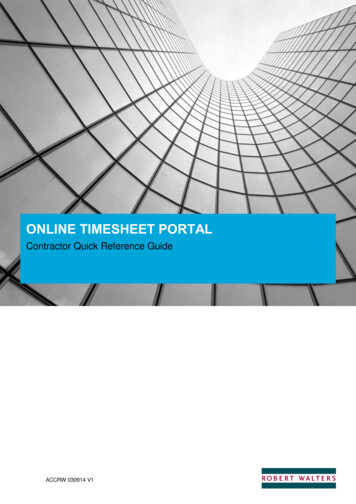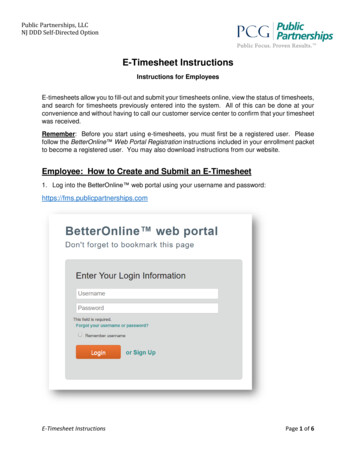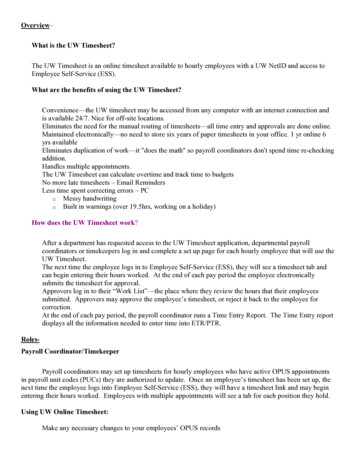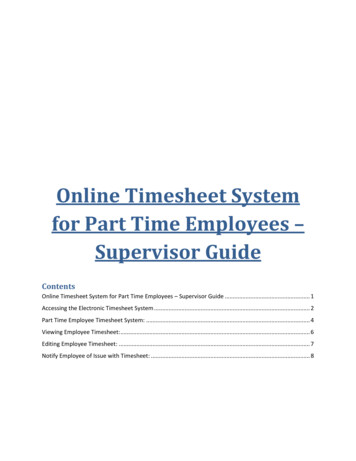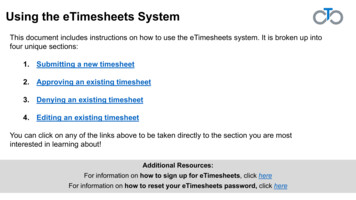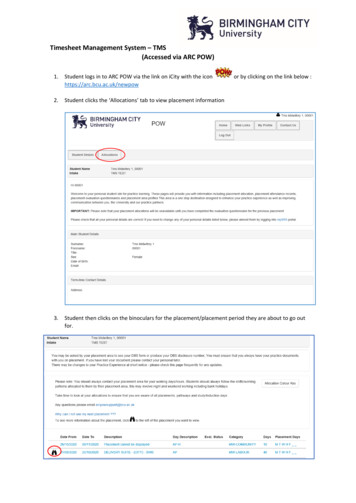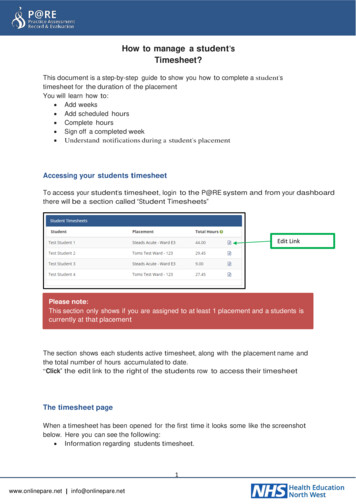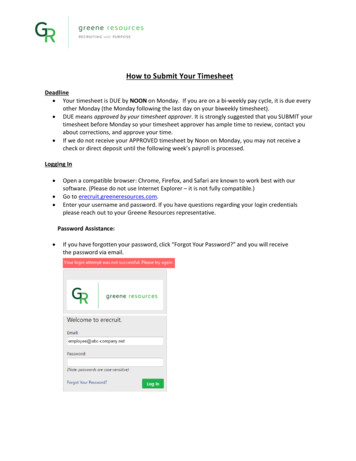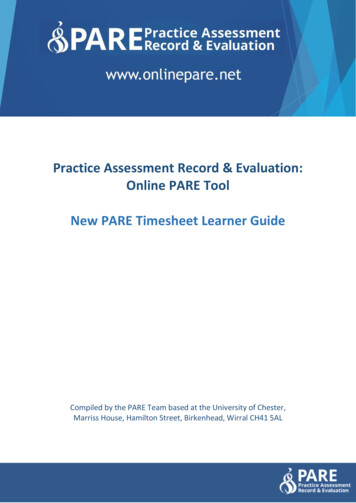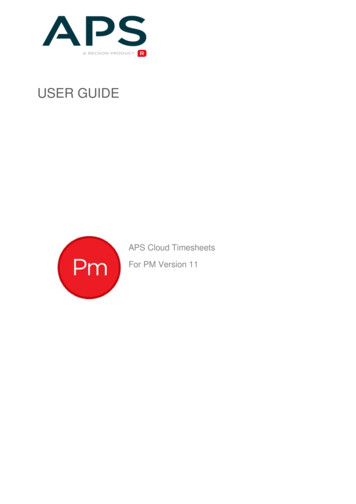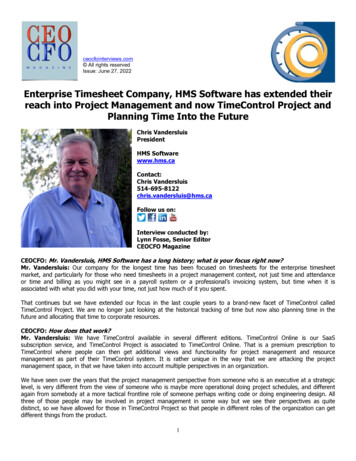
Transcription
ceocfointerviews.com All rights reservedIssue: June 27, 2022Enterprise Timesheet Company, HMS Software has extended theirreach into Project Management and now TimeControl Project andPlanning Time Into the FutureChris VandersluisPresidentHMS Softwarewww.hms.caContact:Chris low us on:Interview conducted by:Lynn Fosse, Senior EditorCEOCFO MagazineCEOCFO: Mr. Vandersluis, HMS Software has a long history; what is your focus right now?Mr. Vandersluis: Our company for the longest time has been focused on timesheets for the enterprise timesheetmarket, and particularly for those who need timesheets in a project management context, not just time and attendanceor time and billing as you might see in a payroll system or a professional’s invoicing system, but time when it isassociated with what you did with your time, not just how much of it you spent.That continues but we have extended our focus in the last couple years to a brand-new facet of TimeControl calledTimeControl Project. We are no longer just looking at the historical tracking of time but now also planning time in thefuture and allocating that time to corporate resources.CEOCFO: How does that work?Mr. Vandersluis: We have TimeControl available in several different editions. TimeControl Online is our SaaSsubscription service, and TimeControl Project is associated to TimeControl Online. That is a premium prescription toTimeControl where people can then get additional views and functionality for project management and resourcemanagement as part of their TimeControl system. It is rather unique in the way that we are attacking the projectmanagement space, in that we have taken into account multiple perspectives in an organization.We have seen over the years that the project management perspective from someone who is an executive at a strategiclevel, is very different from the view of someone who is maybe more operational doing project schedules, and differentagain from somebody at a more tactical frontline role of someone perhaps writing code or doing engineering design. Allthree of those people may be involved in project management in some way but we see their perspectives as quitedistinct, so we have allowed for those in TimeControl Project so that people in different roles of the organization can getdifferent things from the product.1
CEOCFO: Would you give us an example?Mr. Vandersluis: Sure. Someone at a tactical level, someone who is, say, a programmer would probably not beinterested in the overall project schedule. They’re going to be much more interested in just knowing what they would beworking on this week, so TimeControl Project can present them with a View that is often referred to in projectmanagement terms as Agile Project Management by presenting a board of cards on the screen. A supervisor could thendrag a card into that person’s list of things to do this week, and maybe add three or four cards to say that these are thethree or four things that I want you to get done before the week is over. That person would look at that list of cards andimmediately be able to say, “Ok that is great, I know what to do, I know the timeframe to do it in, I can get on and dothe things I do best.”Someone at a strategic level like an executive, has almost no interest in that. As a CEO, where I am putting my own timeright now is thinking about the 2023 budget, the 2022 actuals to date, looking at long-term forecasts, looking at resourcelevels now and for the future. TimeControl Project is able to present to me things like that that are of interest to me in aspreadsheet because that would be most familiar and effective for me.CEOCFO: Would a user pick what they want and setup parameters?Mr. Vandersluis: The way that we have structured TimeControl Project is for an organization rather than an individual.The organization could be modest in size, very large in size, but an administrator controls what views and what datapeople get access to. TimeControl does this already for historical timesheet data. People are not typically able to go intoTimeControl and see everyone’s data. They only deal with the timesheet data of things they should be looking at.TimeControl Project carries that forward as we look into future projections of what work will be coming.“TimeControl was designed around that kind of multi-purpose thinking when we got started and thathas stood us in good stead as we reach markets and industries where the requirements may bedifferent from what we originally were thinking when we wrote the product.” Chris VandersluisAn administrator might make available Board Views with cards on them for people at a tactical level, but not thespreadsheet views. They might make Barchart views available for schedulers but only for the projects they are managing.Data for the executives is likely data that has already been summarized and is already useful for doing analysis, but weprobably would not give that data to every end-user in the company. There is an administrative function in setting thingsup in TimeControl Project but it does not necessarily require HMS to do it.Once the system has been delivered, we see the administrators of the system dividing up the responsibilities for thosedifferent perspectives, taking the default views and then customizing them for their own use, and carrying them forwardlike that. It is not that every user has to figure it out for themselves.CEOCFO: It has been about two months since you announced the Time Control Project. What is thefeedback; what have you learned?Mr. Vandersluis: The feedback has been enormously positive. We have had literally no negative feedback. Everybodyseems very interested. What seems particularly fascinating to me is, depending on who is looking from within a particularcompany, they see something different. We had one client at a very large organization who took a look and said, “ohthese Strategic Views you call them, the spreadsheet views, that is what we really need, that is a part of TimeControlProject that is going to be most useful.” We nodded and said “Of course, you can have those. They’re in the product.”They are looking now at how they will deploy that feature in their organization. This is a person who is a senior director,so he was drawn to that View. In another large organization, the people who were looking at TimeControl Project fromthat organization, were people who do engineering and organization of data, they loved the Board View with the cards,and maybe the scheduling view, so they are looking at deploying that. The Board View was of particular interest to them.Depending on who you are and what your project perspective is, people see something different. We noticed that eveninternally. My own programmers at HMS, love the tactical views, but they of course work in a tactical mode all the time.They are thinking of so many more things they could add to these kinds of views for people like themselves. That is greatof course, however we have to also look for other perspectives. Our senior director say’s “Yeah, I use the spreadsheetview all the time.” I kind of like that. Even in our own office, different people need something different from the product.2
It has been a couple of months but already we are seeing out in the field and from our clients, the feedback that had uswrite this application in the first place, that the perspective of project management is very dependent on what you do andwhat your responsibilities are.CEOCFO: What is the key to having a user-friendly system?Mr. Vandersluis: That is the key to why we started HMS in the first place. We wrote right into our mission statementthat “every client must be referenceable.” We are highly tuned to what our clients are saying. If people were to respondto an inquiry saying, “oh gosh, I am really not happy,” the whole company kind of twists into a pretzel to find out whatwe need to do to make that client happy. We have even hired people that way as part of our hiring process. It is woveninto every part of our culture including the way that we do sales and technical support and so on. In the very first versionof TimeControl, before it was even called TimeControl, back in the early eighties, we realized that what users who weremanagers needed in the interface was not going to be of interest to the end-users.TimeControl lives in the timesheet industry which can be unusual to develop for. There is no one who wakes up in themorning saying, “I can’t wait to do timesheets today.” Maybe an administrator does that or a billing person does that, butmostly people do not. So we do not think we can going make an end-user happy with their timesheet interface. Our goalfor those people is to ask how we can make them the least unhappy. How can we present them with the fewest numberof prompts, provide the easiest path to completing the data, allow the fastest flow through the start to the end of theprocess, and how can we move that forward for them so that there is the least intervention possible?For administrators, we think of TimeControl very differently, we think of how we can add more flexibility so they can havethe application able to adapt to their own processes. End-users do not care about that or anything I have said to you overthe last ten minutes. They only care about how long until they are done with their timesheet. It occurs for them as abarrier between their work week and their weekend. Thinking about what peoples’ experience will be at the differentlevels of the organization is key. When we onboard new employees at HMS, something we did just recently with a coupleof newer programmers onboard, this is part of the learning process for them as it has been for everyone in the company.Programmers and new staff tend to look at something and think “ok this is what I would do”. We have to say, “That’sgreat for you, but what will be the experience of the end-user looking at that function?”We use our own timesheet in the office and if there is some awkwardness with it, people would see that right away. Youhave to make it part of your culture.CEOCFO: How has HMS fared over the last couple of years?Mr. Vandersluis: It has been a challenging time for the economy and we have fortunately done very well during thisperiod. We have grown in the last two years and we remain profitable. One of the things that has helped us more than Iwould have guessed was the rapid adaption of cloud services. Since TimeControl is sold both on-premise and as asubscription in the Cloud, we have the option for prospective or existing clients to choose. We have had some existingclients who have moved from their on-premise deployments to cloud deployments and increased their deployment size atthe same time, which has been great for us. We also have the benefit of being around for over thirty years, so we have agreat depth of client base and recurring revenue. All of those things helped us to start with as the pandemic hit.I think there are a lot of organizations that are slower to adopt or change new systems when they feel that the economyis uncertain and we’re sensitive to that. We feel that with prospects too but it has not hurt our bottom line. Our revenuesand profitability have both done well over the last two years, thankfully.CEOCFO: How do you reach out? What is the business model and how has that changed?Mr. Vandersluis: It has shifted. We used to do a lot of our business as much as 25% to 30% of our business throughdistributors. Just like a lot of industries, the distributor market has really changed and people have moved away from thatmodel. That is not just for HMS, it is also every other software publisher and many other industries. Our direct sales arehow we make our money. We are also both selling licenses for on-premise deployment and our subscription services inthe cloud, the world becomes quite small when you do that and people are able to contact us from anywhere in theworld.3
We have clients in every continent but Antarctica. That is to say we have clients all over. The bulk of them are in NorthAmerica but we service people in Europe, Asia, Australia, and South America. We are multi-national that is all thanks tohow easy it is to communicate directly with prospective clients wherever they are in the world.CEOCFO: Do you find that for your type of product, it is relatively the same in all the geographies or do yousee meaningful differences globally?Mr. Vandersluis: There are a couple of things that are different. Our timesheet in some ways is just a timesheet buteven if I look at just the US market, we have no two clients that think about managing their timesheets the same. If youare thinking about a more international market, well first of all you have to have a multi-lingual product which we do.TimeControl can work in multiple languages. We have people that say they have not just one language but that each usershould be able to select their own and that is how TimeControl is structured as well. Then there are aspects of theproduct that you might not think of if you were just programming in the local market for the US or Canada. We have tothink also about requests like “I have to change the currency symbol, I have to be able to change how the currency isdisplayed, how many decimals we have.” We support all of that which is kind of basic but there are also differences interms of what data is collected and how people think of it. In some cultures, and some countries, the level of detail canbe of a concern. Collecting information for example, about sick leave can be highly sensitive depending on where you are.Collecting information about work done for certain kinds of clients can be sensitive in different areas.We fortunately made a product that is extremely flexible and it has been able to adapt to those kinds of requests.Probably the biggest place in TimeControl where we see big differences is in the way timesheets data is approved. Insome organizations, it is very simple, in some organizations highly complex, in some organizations this kind of data has tobe approved by different parts of the organization before it can be accepted. We support all of that in TimeControl. Thatcame from the very start. When we started TimeControl we started it as a system that would support both projectmanagement and Finance requirements. TimeControl was designed around that kind of multi-purpose thinking when wegot started and that has stood us in good stead as we reach markets and industries where the requirements may bedifferent from what we originally were thinking when we wrote the product.CEOCFO: How do you help your customers who may be having some challenges with your system? Howand why is high level customer services important for HMS?Mr. Vandersluis: We do have a high level of service; in fact, I was just writing about that recently. Somebody had triedto pitch to me using a Chatbot and I said, “I’m sorry but I’m just not interested in that for our market.” They said, “Butour Chatbot is so great.” I replied, “I sure it is great, and will be very appropriate for certain kinds of clients but not forthe way we have structured the communications and support of our clients.” Once TimeControl is established in anorganization, the kinds of requests that we get are typically process requests, “Hi, we want to change our process,” or “Hiwe have an issue with a new process, we want to extend the way we are doing our timesheets.” or “We want to use thetimesheets for a new process internally and we need some help.” That requires a high level of response not just “Ipushed the blue button and I did not see what I expected when you push the blue button.” Those kinds of problems gethandled during QA.If we encounter an actual bug out there, it gets fixed instantly because it is such a high-priority issue for us. TimeControlis used for financial processes like Payroll. We can’t afford to have basic functionality not working. The kinds of requeststhat we are more likely to get are more complex. One of the ways we handle that is we rotate all of our technical staff sosomeone in technical support will also at some point be doing deployment. Somebody who is a programmer will do atsome point do QA. Somebody that is doing at QA will also at some point deal with design of new features. What ends uphappening is we end up with all of our technical people being quite well-rounded as opposed to just a tech supportperson who will have to escalate the requests to somebody who knows what the code looks like. If you had theexperience of having a technical problem and having to call in, you may have had someone tell you that they wouldescalate that to a developer. That does not happen with us, every call has already escalated to a developer because thatis what who is talking when you call.CEOCFO: When did you recognize you should cross-train all of your people?Mr. Vandersluis: When we hired the very first person. When you are starting a company, it kind of happensautomatically because everyone wears every hat. As we hired people, we realized that was one of our strengths and thatthe people should wear all the hats just like we always did, so the incentive to say, “let us just hire developers who do4
not have to talk to people,” was never attractive to us. Maybe it’s easier to just hire people to write code and otherpeople who can talk to folks but are not as technically advanced and maybe that might have been cheaper for us but wewould not have developed the same level of customer satisfaction.CEOCFO: What is ahead for HMS Software?Mr. Vandersluis: We just released Time Control 8.3, which is an upgrade to what we have been doing. We are nowshifting into an innovative mode for a much bigger release at the end of the year. In terms of products, we now haveTimeControl and TimeControl Industrial for on-premise, TimeControl Online and TimeControl Industrial Online for oursubscription service, and TimeControl Project Online. We have five different editions that we are advancing and they allare designed on the same code base, so they all have to advance at the same time.In terms of TimeControl features, we have a list of very exciting things that we want to attack over the next six or sevenmonths. In terms of the business, we are expanding. We are bigger now than we were last year, we see ourselvesexpanding again next year. We are not trying to expand at a rapid rate. We are conservative in our growth plans and thatfits in well with the uncertainty that can come with the economy we are “slow and steady wins the race.” That has beenand will continue to be our goal.5
Enterprise Timesheet Company, HMS Software has extended their . Our company for the longest time has been focused on timesheets for the enterprise timesheet . not just time and attendance or time and billing as you might see in a payroll system or a professional s invoicing system, but time when it is associated with what you did with your .
